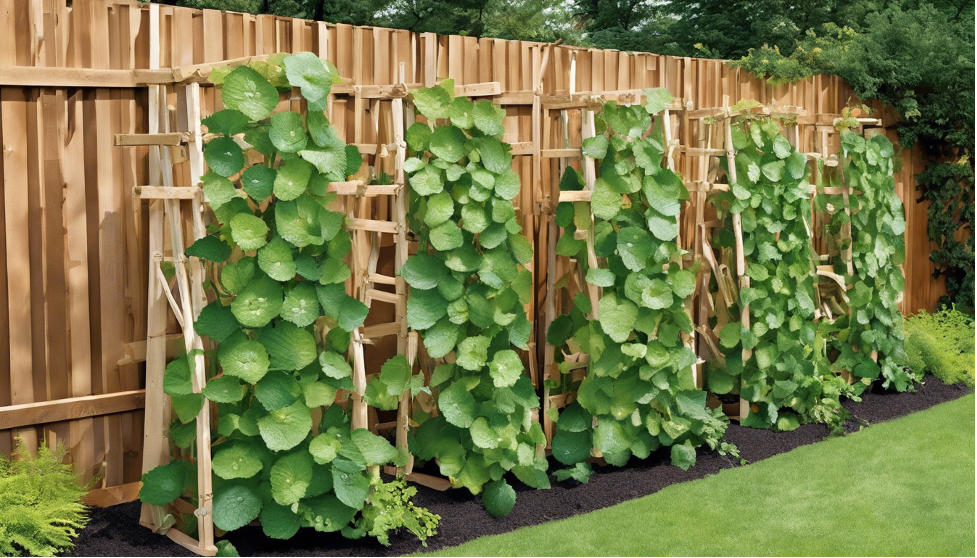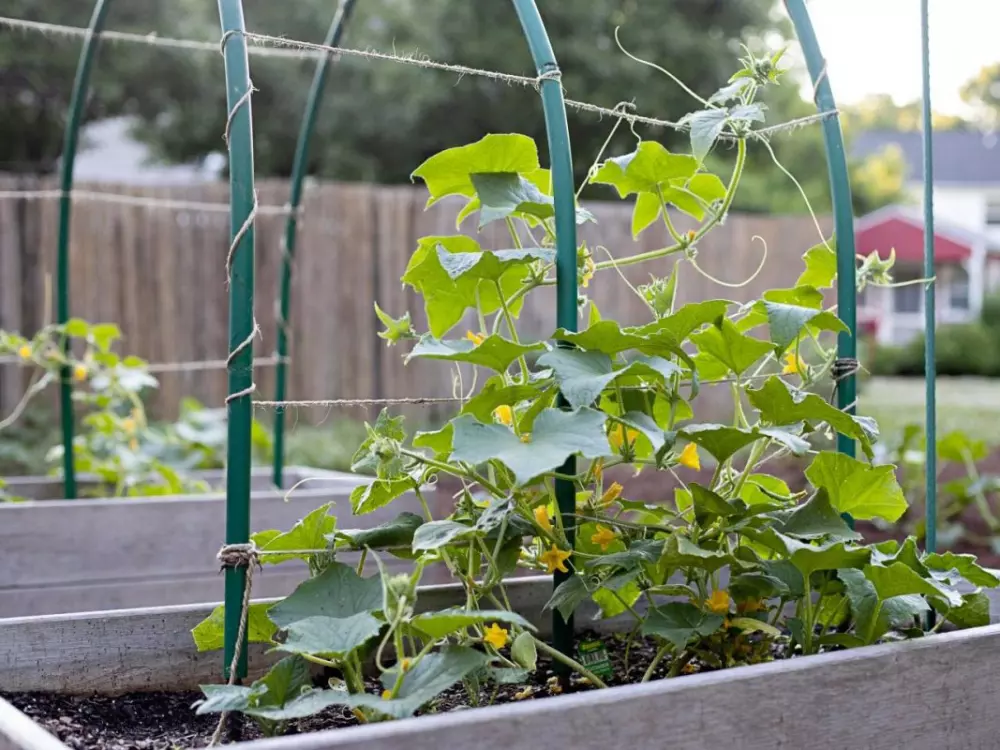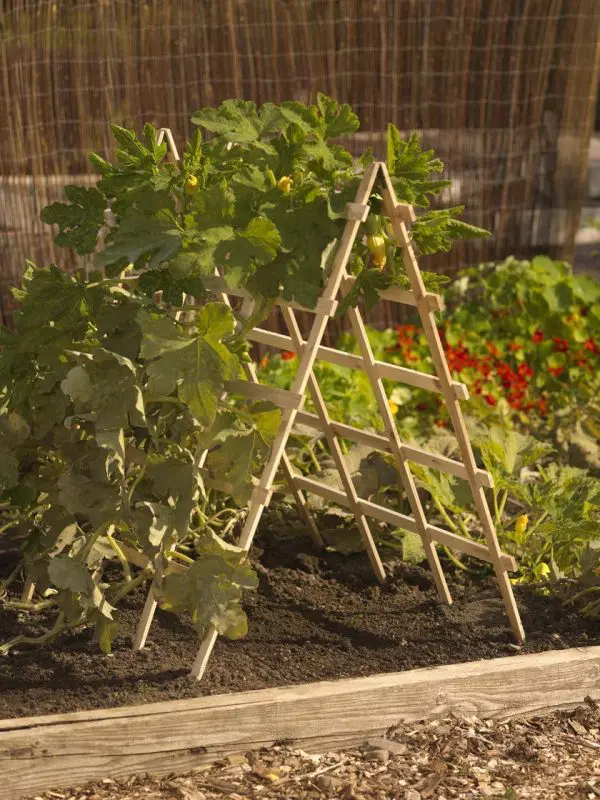
Creating a supportive environment for cucumbers to thrive is essential to maximize the yield and the health of plants. A cucumber trellis is not just a functional element of vegetable gardening. It’s a transformative tool that can significantly enhance the growth, quality, and accessibility of cucumbers.
By elevating the vines off the ground, a trellis improves air circulation, reduces the risk of diseases, and facilitates easier harvesting. This simple yet effective gardening solution is a testament in maximizing the potential of a garden space.
The ensuing sections will delve into a variety of creative cucumber trellis ideas that cater to different preferences and garden sizes. From the classic wooden lattice cucumber trellis that offers durability and aesthetic appeal to the inventive use of recycled materials for a more sustainable approach, each option presents its unique advantages.
Gardeners can also explore the practicality of a bamboo A-frame trellis, the simplicity of a string and post cucumber trellis, or the elegance of decorative obelisk and arch trellises.
These ideas not only serve the functional purpose of supporting cucumber vines but also add a visual charm to the garden landscape, demonstrating that practicality and beauty can go hand in hand in garden design.
Wooden Lattice Cucumber Trellis
Benefits
Wooden lattice trellises provide a sturdy, vertical structure that allows cucumber plants to climb and spread out, maximizing the available growing space.
This setup not only increases air circulation and sunlight exposure for the plants, which can improve growth and reduce disease risk, but also facilitates easier harvesting since cucumbers are elevated off the ground.
Additionally, it reduces the risk of the cucumbers becoming misshapen or developing blemishes from resting on the soil.

Materials Needed
To construct a wooden lattice cucumber trellis, gardeners will need the following materials:
- Wooden posts or stakes (4×4 or 6×6 inches in diameter, 6-8 feet tall)
- Wooden lattice panels (typically 4×8 feet in size)
- Screws or nails
- Hammer or power drill
Construction Steps
- Determine the size and placement of the trellis: Measure the area where you plan to grow the cucumbers and decide on the dimensions of the trellis.
- Install the wooden posts or stakes: Dig holes for the posts, spacing them 4-6 feet apart, and set them in the ground, ensuring they are level and stable.
- Attach the lattice panels to the posts: Secure the lattice panels to the posts using screws or nails, making sure the panels are level and evenly spaced.
- Add any additional support or bracing, if needed: This ensures the trellis is sturdy and can support the weight of the growing cucumbers.
By following these steps, gardeners can create an effective and attractive wooden lattice cucumber trellis that enhances the functionality and appearance of their garden.
A-Frame Cucumber Trellis

Advantages
An A-frame cucumber trellis provides several benefits to gardeners aiming to maximize their cucumber yield.
Firstly, it capitalizes on the natural climbing instincts of cucumbers, promoting better pollination and increased crop production. The structure of an A-frame trellis also facilitates more efficient use of garden space, allowing for additional planting underneath the trellis.
This vertical growth enhances air circulation around the plants, which is crucial for minimizing disease and ensuring healthier, more robust cucumber plants.
Furthermore, the design of the A-frame trellis means that cucumbers hang down in the middle of the structure, making the fruits more visible and easier to harvest. This method of growing cucumbers off the ground also reduces the likelihood of fruit catching diseases commonly found in soil contact.
Materials Required
To construct an A-frame cucumber trellis, gardeners will need the following materials:
- Two 2″x4″x8′ pressure-treated boards, which can be cut in half to create four 2″x2″x8′ boards. Alternatively, four 2″x2″x8′ boards can be purchased directly.
- A trellis net, ideally 8 feet long to match the length of the A-frame structure.
- Screws, specifically 4″ deck screws for assembling the frame.
- A hammer or power drill for securing the screws.
- A staple gun for attaching the trellis net to the frame.
Building Process
- Determine the dimensions: Decide on the desired height, width, and length of the A-frame trellis. A common size is approximately 3.5 feet tall by 4 feet wide, to fit within a standard raised bed.
- Cut and prepare the boards: Cut the 2″x4″x8′ pressure-treated boards in half to create four 2″x2″x8′ boards. For each side of the A-frame, cut one of the 8-foot sections in half again, giving two 4-foot lengths. Miter one end of these sections at a 45-degree angle to form the peak of the A-frame.
- Assemble the A-frame sides: Place the two 4′ sections together, mitered edges at the top, ensuring the legs are 4 feet apart. Secure the top edge with a 4″ deck screw. Create the middle support by cutting a 2-foot section from one of the remaining 2″x2″x8′ boards, mitering each end at a 22.5-degree angle, and securing it between the legs of the A-frame.
- Connect the two sides: After assembling both sides of the A-frame, use the remaining 2″x2″x8′ board cut into two 4-foot sections to connect the sides at the top and halfway down each side using 4″ deck screws.
- Attach the trellis net: Start by stapling one bottom corner of the trellis net to the frame. Stretch the netting across to the opposite bottom corner, ensuring it is tight, and staple it in place. Continue stretching and stapling the netting along one side, then the other, until it is fully secured to the frame.
By following these steps, gardeners can construct a sturdy and functional A-frame cucumber trellis that not only supports the healthy growth of cucumber vines but also adds aesthetic value to the garden.
Recycled Materials Cucumber Trellis
Pros
Utilizing recycled materials for a cucumber trellis not only benefits the environment by reducing waste but also provides a cost-effective solution for gardeners. These materials can be repurposed to create sturdy and functional trellises that support the growth of cucumber plants, ensuring they receive adequate air circulation and sunlight. Moreover, recycled trellises can be uniquely designed to add a creative touch to the garden space.
Types of Recycled Materials
A variety of items can be transformed into effective cucumber trellises. Old poles, tree branches, broom sticks, or even crutches can serve as the vertical supports for the trellis. Additionally, items like old closet organizers or broken patio umbrella wooden supports can be creatively repurposed. These materials not only make the project sustainable but also allow gardeners to customize the trellis to fit their specific garden aesthetics.
How to Assemble
- Select and Prepare Materials: Gather all recycled materials such as old poles or wooden slats. If using a closet organizer or similar structure, ensure it is cleaned and painted if desired.
- Cutting to Size: Depending on the height of the cucumber plants, cut the materials to the desired length. Common lengths for cucumber trellises are around 4 to 8 feet.
- Assembling the Frame: Arrange the vertical supports (poles or wooden slats) and secure them at the base using strong tape or directly into the ground. If using a closet organizer or umbrella supports, position them to create a stable frame.
- Adding the Lattice: Create a lattice with string, twine, or additional wooden slats. Attach this to the frame by tying or nailing it in place, ensuring it is tight and secure. This lattice will support the cucumber vines as they grow.
- Stabilization: Ensure the trellis is stable enough to withstand wind and the weight of the plants. This may involve anchoring the trellis to the ground with stakes or additional supports.
String and Post Cucumber Trellis
Why Choose This Method
The string and post cucumber trellis offers a practical solution for gardeners dealing with the challenges of growing cucumbers, which require adequate support to thrive. This method is not only cost-effective but also highly effective in helping cucumber vines climb and produce abundant harvests. The structure allows for optimal sun exposure and air circulation, which are critical for the health and productivity of the plants.
Necessary Supplies
To construct a string and post cucumber trellis, gardeners need to gather a few basic supplies:
- Wooden posts or stakes, ideally 4-6 feet tall, to serve as the main supports
- Durable twine or string to create the climbing structure
- A hammer or mallet, which will be used to drive the posts into the ground
These materials are readily available and can be easily assembled to create a sturdy trellis.
Step-by-Step Instructions
- Layout Planning: Determine the desired length and width for the trellis area. Arrange where each post will be placed, ensuring they are evenly spaced about 4-6 feet apart.
- Post Installation: Securely drive the wooden posts into the ground. They should be deep enough to stand firm and support the weight of mature cucumber vines.
- String Attachment: Tie the twine or string horizontally between the posts. Start from the bottom and space the strings about 12 inches apart as you work your way up. This will form a grid-like structure for the vines to climb.
- Vine Training: As cucumber plants grow, gently guide them towards the trellis. Weave the vines through the horizontal strings to encourage upward growth.
- Maintenance: Regularly inspect the trellis to adjust and secure the vines. This ensures they continue to climb the trellis and do not sprawl on the ground.
By following these steps, gardeners can effectively support their cucumber plants, enhancing both the garden’s functionality and its aesthetic appeal.
Decorative Obelisk and Arch Trellis
Unique Features
Decorative obelisks and arch trellises serve not only as functional supports for climbing plants but also as striking visual elements in the garden. An arch trellis can transform a simple garden path into an inviting grand entrance or create a focal point within the garden.
These structures are particularly effective in maximizing garden space by encouraging vertical growth, thereby allowing more area for other gardening activities.
On the other hand, obelisks, often designed with a narrowing top, can prevent overcrowding of climbing plants, ensuring they receive ample air and sunlight. This architectural feature is especially useful in raised beds or container gardens, where space is limited.
Materials
For those looking to integrate these structures into their gardens, a variety of materials are available.
Metal trellises, including those made from powder-coated steel, offer durability and longevity, resisting rust for extended periods.
Wooden obelisks, crafted from landscape cuttings or bamboo, provide a rustic, natural aesthetic that blends seamlessly with the garden environment. These can be either crafted at home from simple materials like bamboo in various sizes, depending on the garden’s requirements.
Building Guide
Constructing an obelisk or arch trellis can be a rewarding DIY project. For an obelisk, begin by selecting straight furring strips, which will form the legs of the structure.
Measure and cut additional pieces to form cross supports, ensuring all parts are securely attached using waterproof glue and nails or screws for enhanced stability. When building an arch treilis, start by assembling the main frame from metal or wooden rods, ensuring all connections are tight and secure.
Attach decorative elements, such as swirls or rings, to enhance the structural integrity and aesthetic appeal of the trellis. Finally, secure the trellis in the garden, using stakes or bases to ensure it remains upright and stable.
By following these steps, we can create beautiful and functional decorative obelisks and arch trellises to support plant growth and add a touch of elegance to the garden landscape.
Conclusion
Throughout this exploration of creative cucumber trellis ideas, we have observed a wide array of options that cater to different styles, space considerations, and environmental concerns.
From the sturdiness and aesthetic appeal of wooden lattice and the practicality of A-frame models to the ingenious employment of recycled materials and the simplicity of string and post structures, each approach offers distinct benefits.
Importantly, the inclusion of decorative obelisks and arches demonstrates how functionality can seamlessly intersect with beauty, transforming utilitarian garden setups into captivating landscape features.
The adoption of a suitable trellis system not only elevates the growth and yield of cucumber plants but also contributes significantly to the overall design and efficiency of the garden.
By fostering better air circulation, reducing disease risks, and facilitating ease of harvest, these trellising solutions highlight the importance of strategic planning in garden management.
As we conclude, gardeners are encouraged to experiment with these ideas, perhaps combining different methods to fit their unique garden spaces, thereby enhancing both the productivity and aesthetic appeal of their gardening endeavors.
FAQs
What are some innovative trellis designs for cucumber plants? There are numerous trellis ideas suitable for cucumbers and other climbing plants, including:
- Lattice
- Metal mesh
- A-frame structures
- Arches
- Twine and posts
- Tipi-style supports
- Wire cages
- Utilizing existing fences
Is it better to have a cucumber trellis vertical or angled? Cucumber plants benefit greatly from vertical trellising. This method allows the plants to grow larger, produce more fruit over a longer period. It helps maximize garden space by growing upwards.
What is the most effective support structure for cucumber plants? For supporting cucumbers effectively, consider constructing a wigwam using tall bamboo canes or using sturdy netting held up by vertical stakes. Additionally, cucumbers can be trained to climb up trellises, wires, or even along walls and fences.
Should cucumbers be grown on a trellis or in a cage? Growing cucumbers on a trellis is generally preferable. Trellised cucumbers are easier to harvest and tend to be less prone to diseases compared to those that spread on the ground. Thus, allowing cucumbers to climb a trellis is often the best choice for healthier plants and a more bountiful harvest.